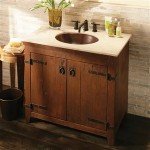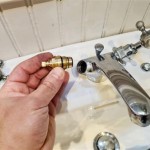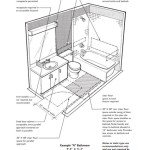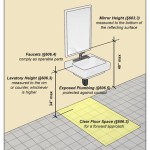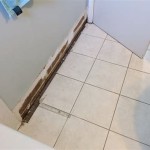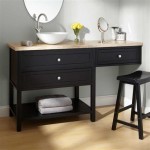A bathroom exhaust fan with a heater is a valuable addition to any bathroom, improving ventilation, controlling humidity, and providing supplemental warmth, particularly during colder months. However, installing such a unit requires careful planning and precise electrical wiring. This article provides a comprehensive guide on how to safely and effectively wire a bathroom exhaust fan with a heater, ensuring optimal functionality and adherence to electrical codes.
How To Wire A Bathroom Exhaust Fan With Heater
Prior to commencing any electrical work, it is paramount to prioritize safety. This includes disconnecting power to the circuit at the main electrical panel, verifying the absence of voltage using a non-contact voltage tester, and adhering to all local electrical codes. Ignoring these precautions can lead to severe electrical shock or fire hazards. Furthermore, it is strongly recommended that individuals with limited electrical experience seek assistance from a qualified electrician. This guidance is intended for informational purposes only and does not constitute professional electrical advice.
Bathroom exhaust fans with heaters generally require dedicated circuits due to their higher power consumption compared to standard exhaust fans. Overloading an existing circuit can trip breakers and potentially cause a fire. Therefore, the first step involves determining if a suitable circuit already exists or if a new one needs to be installed. This determination depends on the existing electrical infrastructure and the amperage rating of the fan/heater unit.
Understanding the wiring diagram for your specific model is crucial. These diagrams are typically included in the product documentation provided by the manufacturer. They illustrate how the various components of the fan and heater connect, as well as the wiring requirements for the power supply and control switches. Failure to adhere to the wiring diagram can result in malfunction, damage to the unit, or electrical hazards.
Key Point 1: Preparing for the Installation
Before beginning the wiring process, gather the necessary tools and materials. These typically include: a non-contact voltage tester, wire strippers, wire cutters, screwdrivers (both Phillips and flathead), pliers, wire connectors (wire nuts or push-in connectors), electrical tape, appropriate gauge electrical wire (typically 12 or 14 AWG, depending on the amperage requirements), a circuit breaker (sized appropriately for the circuit, usually 15 or 20 amps), and the replacement bathroom exhaust fan with heater.
Next, prepare the wiring at both the electrical panel and the bathroom location. At the electrical panel, identify an available space for a new circuit breaker. If adding a new circuit, install the breaker, but leave it in the "off" position for now. Run the appropriate gauge electrical wire from the electrical panel to the location in the bathroom where the exhaust fan with heater will be installed. Secure the wire along its path, using cable staples or other appropriate fasteners to prevent it from dangling or becoming damaged. Ensure the wire is long enough to reach both the electrical panel and the fan/heater unit with sufficient slack for making connections.
In the bathroom, determine the optimal location for the exhaust fan with heater. This is typically above the shower or toilet, where moisture and odors are most concentrated. If replacing an existing fan, remove the old unit, being careful to disconnect the wiring and note the connections' configuration. If installing a new unit, cut an appropriately sized hole in the ceiling according to the manufacturer's instructions and install the mounting bracket or housing for the new fan/heater unit. Ensure the housing is securely attached to the ceiling joists.
Verify that the wiring at the fan/heater location is easily accessible and free from obstructions. Strip the ends of the wires to expose the copper conductors, being careful not to nick or damage the wires. This exposed copper will be used to make the electrical connections. At the electrical panel, also strip the ends of the wires that will be connected to the circuit breaker and the neutral bus bar.
Key Point 2: Wiring the Exhaust Fan/Heater
The wiring process involves connecting the electrical wires to the corresponding terminals on the fan/heater unit and the circuit breaker in the electrical panel. The specific wiring configuration will vary depending on the model and the desired functionality (e.g., separate switches for the fan and heater). However, the basic principles remain the same.
Typically, the fan/heater unit will have three or four wires: a black wire (hot), a white wire (neutral), a green or bare copper wire (ground), and potentially a red wire (often used for the heater). The black wire connects to the hot wire from the circuit breaker, providing the power supply. The white wire connects to the neutral wire from the circuit, completing the circuit. The green or bare copper wire connects to the grounding terminal, providing a path for electricity to safely dissipate in the event of a fault.
Use wire connectors (wire nuts or push-in connectors) to make the electrical connections. Twist the wires together securely and then screw on the wire nut, ensuring that no bare copper is exposed. If using push-in connectors, insert the stripped wires into the appropriate openings, ensuring a secure connection. Wrap electrical tape around the wire nuts to provide additional insulation and prevent accidental loosening. Ensure all connections are tight and secure this reduces the risk of arcing and overheating.
If the fan/heater unit has a separate red wire for the heater, it will typically need to be wired to a separate switch. This allows the heater to be controlled independently of the fan. This usually involves running an additional wire from the switch to the fan/heater unit and connecting it to the red wire. Consult the wiring diagram for specific instructions on how to wire the separate switch.
At the electrical panel, connect the black wire from the circuit to the terminal on the circuit breaker. Tighten the screw on the terminal to secure the wire. Connect the white wire from the circuit to the neutral bus bar. This is typically a metal bar with multiple terminals where all the neutral wires are connected. Connect the green or bare copper wire from the circuit to the ground bus bar. This is typically a metal bar with multiple terminals where all the ground wires are connected.
Key Point 3: Testing and Verification
Once all the wiring is complete, it is essential to test and verify that everything is working correctly. Before turning on the circuit breaker, double-check all the connections to ensure they are secure and properly insulated. Make sure no bare wires are exposed and that all the wire connectors are tightly fastened.
Turn on the circuit breaker at the electrical panel. Using a non-contact voltage tester, verify that the wiring to the fan/heater unit is properly energized. Be careful not to touch any exposed wires or terminals while testing.
Turn on the fan and heater using the control switch(es). Verify that both the fan and heater are functioning properly. Check for any unusual noises, vibrations, or odors. If anything seems amiss, immediately turn off the circuit breaker and investigate the problem. If the fan or heater does not turn on, double-check the wiring connections and the switch positions.
Monitor the fan and heater for a period of time to ensure they are operating safely and efficiently. Check for any signs of overheating or electrical problems. Ensure the ventilation is adequate and that the humidity is being effectively controlled. Listen for any unusual sounds or vibrations. If everything seems to be functioning correctly, the installation is complete.
Properly dispose of any waste materials, such as old wiring, packaging, and discarded parts. Clean up the work area and ensure it is safe and free from hazards. Keep the wiring diagram and installation instructions for future reference.
Regularly inspect the exhaust fan with heater to ensure it is functioning properly. Clean the fan blades and housing to remove any dust or debris. Check the wiring connections for any signs of corrosion or damage. Replace the unit if it becomes damaged or malfunctions.
By following these guidelines and taking the necessary precautions, individuals can safely and effectively wire a bathroom exhaust fan with a heater. However, as noted earlier, it is strongly recommended that individuals with limited electrical experience seek assistance from a qualified electrician to ensure the installation is done correctly and safely. Remember that electrical work can be dangerous, and it is always better to err on the side of caution.

How To Add Exhaust Fan Heater Light Fixture Combination

Bathroom Heater Light Fan Installation Information Purchase Ie

Wiring To A Heat Vent Light In The Bathroom Doityourself Com Community Forums

Wiring Diagrams For A Ceiling Fan And Light Kit Bathroom Exhaust Home Electrical Switch

Exhaust Fan Wiring Diagram Timer Switch
Bathroom Light Exhaust Fan Heater Wiring Page 2 Diy Home Improvement Forum

Broan Bhfled80 Powerheat Bathroom Exhaust Fan Heater Installation Guide

Broan Nutone Powerheat 80 Cfm Ceiling Bathroom Exhaust Fan With Heater And Cct Led Lighting Bhfled80 The Home Depot

Extractor Fan Wiring Diywiki

How To Put Bath Fan And Light On Separate Switches Instead Of One Switch
Related Posts
